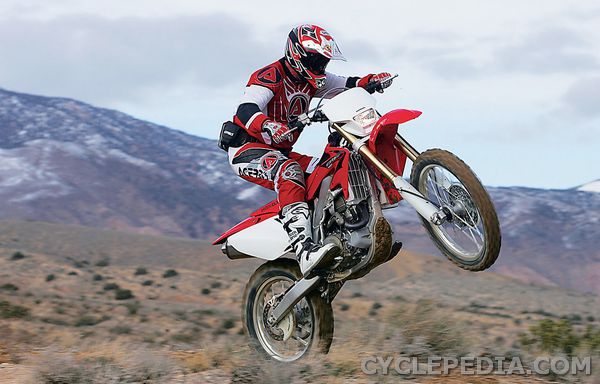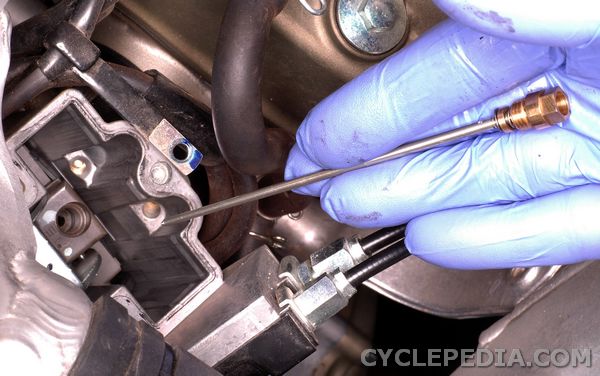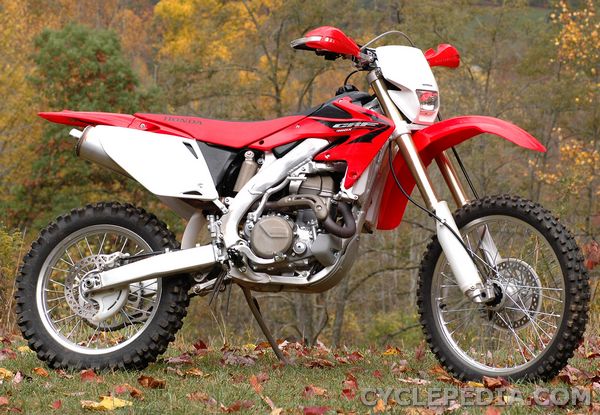Old-School Open Class
(Adapted, with permission, from Trail Rider magazine January 2006)
Surrounded by high revving four-strokes of every size, it is a treat to get on the CRF450X and relive the days of real low-end power. Honestly, the CRF450X has the powerband the venerable XR400 really needed. The 450X is all low end; just a grunty, torquey engine that is a pleasure to short-shift through the woods. In our mind, that’s the main compelling feature of the CRF450X. If you’re sick of buzzing your brains out on the trails, this is the bike for you.
When the CRF450X was released in 2005, the only thing that Honda carried over from the 250X is the color. To fit the 450 engine, everything had to be scaled up and re-worked. That leaves the 450X a bigger bike than the 250X, plain and simple. You’re never going to feel that difference because the seat height is exactly the same between the two bikes, and the wheelbase is actually listed as four tenths of an inch shorter on the 450. However the frame is bigger and beefier in the places that matter.
Honda’s literature also points out that this bike is entirely different from the 450R motocrosser as well. The major differences are all aimed at making the 450X more compliant and comfortable on the trail, as compared to the racing-stiff 450R; primarily meaning they engineered more flex into the chassis and suspension. The sum total of major parts carried over from the 450R into the 450X is three, basically–two aluminum frame spars in the cradle section of the frame, and the piston and rings. Everything else is different.
The 450X’s suspension is similar to the 250X. Both bikes use the 47mm Showa inverted cartridge fork, which, most suspension tuners will tell you, is very possibly the best set of forks made in 2005. They are smooth and compliant over the little stuff and rock solid over the big stuff, and anybody who can find something to complain about with these forks just simply wants to be contrary. One very neat feature of these forks is that the compression damping valving lives right in the upper fork cap. Changing the valving on the 47mm Showa forks is as easy as taking the top cap off and modifying the shim stack—you don’t have to strip the forks down to nothing to get at the shims. The 450 is also using the same basic Showa rear shock as the 250X, although with different valving and spring rate.
If anything, we would say that the 450X was very sensitive to differences in terrain and we’d expect any picky rider to want to revalve the forks and shocks. The stock 450X seems to work fine in the southern California desert, but the damping feels too stiff for comfortable riding in the tight woods of the east coast. If you don’t race much, you might get away with backing off the compression damping clickers, but you’ll be much happier paying a tuner for a good revalve job.
While all this suspension “feeling” was going on, we noticed that the 450 handles almost exactly the same as the 250X. It’s got a light touch, very much like a Honda CR250. Compared to a European enduro bike, this “Honda feel” is so light it might be spooky—the front wheel hardly seems to touch the ground. But once you get used to it you get spoiled. Bikes that handle this easy can be ridden long miles without tiring you out.
We replaced both the shock and fork springs with the next lightest size, .45 kg fork springs and a 5.4 kg shock spring. We also had Enduro Experts in New Gretna, NJ, take the fork and shock apart and change the shim stacks to flow more oil in both directions. It’s amazing what a competent suspension tuner can do with a bike like this, and the good part about Honda’s Showa suspension components is that everyone is familiar with them and they are easily modified. They are also, by the way, among the best-made, highest quality suspenders out there, so it pays to have them valved to suit you and maintained properly.

One thing we noticed about the Showa suspension components is that they definitely need time to break in. Did you know that the accepted method of hastening break-in on suspension components is to crank the adjusters out all the way, and then ride the bike carefully for a half-hour or so to get everything warmed up? Then you set the clickers to the factory setting and adjust from there. And also, the way the bike feels or reacts to your input is all subjective—in other words you might like the suspension fine once you get 200 miles on the bike. The only way to know for sure is to test and evaluate. Sand riders may be pretty happy with the stock bike, but we know most every rock rider is going to want to change some valving.
Aiding all this turning and bump absorption is a set of typical Honda brakes, and we have to say that the things people have been saying about Honda brakes all these years are all true. The Nissin hydraulic brakes aboard the CRFs—any CRF, and for that matter, any CR—are the standard by which every other brake system has to be judged. These brakes are perfect, no other word for them.
All this talk about suspension and handling is all well and good, but the first thing you’re going to notice about the 450 is the way the engine works. Obviously, Honda could have gone in any direction with the 450X engine. They could have made it into a fierce midrange/top end screamer like the KTM 450 EXC, or they could have built a low midrange tractor like the Yamaha 450WR. They didn’t come close to either of them; instead Honda has built maybe the most perfect open class four-stroke engine we have felt to date. The power comes on right at the very bottom of the rev range, and it comes on strong. It builds up to the midrange seamlessly, pulling like a mule the entire time. There is no huge midrange “hit”, and though the engine will rev up to 9000 or so, it doesn’t make any sense to spin it that high, because all your power is happening down low.
So what Honda has done here is build an engine with really easy to ride, low-end and midrange power, and plenty of it. You will not feel this bike flatten out and fall on its face on a hillclimb; not unless you forget to shift down from third.
The power ouput on the 450X can be improved, though. The simplest improvement is to change the needle. We switched to the NCYS needle in the third clip position (P/N 16204-MEN-671). We set the fuel mixture screw at about one and five-eighths turns out and haven’t opened up the airbox at all. We haven’t changed any of the other carb jets.
With the new needle the bike gained even more smoothness off the bottom and into the midrange, and none of the existing positive traits of the powerband were compromised. We also noticed easier starting after we changed the needle and dialed in the mixture screw, evidence that it wasn’t exactly right as delivered. Four-strokes like the starting circuit to be perfectly tuned, and if it’s a little rich or even a little lean the bike will be balky to start. The 450X always started quickly with the kicker—but we used it rarely. The button is so much easier.

The jetting changes were done without changing the stock silencer or removing the exhaust baffle. And like we said, we didn’t modify the airbox at all. The end result is a fast, fun to ride bike that is super quiet. It is difficult to hear the bike coming through the woods, and that’s a good thing. A great thing, actually. Keep your 450X like this and we’ll lose a lot less riding ground because of noise.
Because of all the power on tap the stock gearing feels perfect. There are no odd gaps in the gearing and first feels low enough without being too low, while top gear should be sufficient for all but the craziest of riders.
Everything is fitted perfectly on this bike, which is good and maybe sometimes bad, if you’re light on patience. The carburetor, for example, is so far out of harm’s way you can hardly see it. That’s good, but if you have to work on the jetting you have to take the entire back of the bike apart to do it. Oh, Honda gives you a special little tool for getting the needle out of the carb for adjustments, and you can figure out how to do it if you’re good. But for anything else on that carb, better plan to pull the subframe loose and disconnect the airbox. It’s just a fact of life on a perimeter-frame bike. The great thing is, though, if you only need to change the jet needle, it can be done by removing the seat and pushing some wires and hoses out of the way.
But wait, we take that back—somewhat. We installed one of Ty Davis’ big-knobbed replacement mixture screws without doing much more than rotating the carb a little bit. It wasn’t easy, but we did it.
For any other kind of surgery, the bike is pretty easy to get along with. For example, there’s a no-tools door on the airbox to get the filter out. That’s nice. Both of the oil drains are easily within reach, and the oil fillers are also very reachable. This is good because you really need to replace the oil as often as possible on this bike to keep the valve train happy.
What’s left? The frame components are typical Honda quality. Stock Renthal bars, comfortable seat, crisp shifting, good brakes with 240mm rotors front and rear, reasonably quiet spark arrestor/muffler, all kinds of adjustments on the suspension pieces, easy access to the airbox. Honda says the engine assembly on this bike weighs only 71 pounds, and that the total bike weight is approximately 255 dry. Like the 250X, this bike does feel light when you ride it.
The bike has a reasonable sized 2.27 gallon fuel tank, 18-inch rear wheel, of course, and a 35-watt halogen headlight and Honda’s nifty LED taillight. Honda also supplies the stock bike with quality Renthal handlebars.
The 450X has larger radiators than the 250X, which is good, it helps keep the big bike cooler. There’s also a stepped clutch cover which increases the oil capacity for the five speed transmission, and an eight-plate clutch in there as well.
The best part of the 450X is its versatility. You can putt along on trails with it, race enduros or hare scrambles easily. If you wanted to change the wheels, it would be perfectly suitable for a Supermotard bike.
All in all, we like it. For a big-bore bike it’s easy and fun to ride, quiet in the woods, and can be a capable amateur enduro and hare scrambles racer. What could be any better than that?




Leave a Reply
You must be logged in to post a comment.